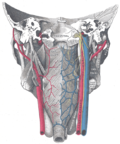| Stylopharyngeus muscle | |
|---|---|
 | |
| Details | |
| Origin | Temporal styloid process |
| Insertion | Thyroid cartilage |
| Nerve | Glossopharyngeal nerve (CN IX) |
| Actions | Elevates the larynx, elevates the pharynx, dilates the pharynx; facilitates swallowing |
| Identifiers | |
| Latin | musculus stylopharyngeus |
| TA98 | A05.3.01.114 |
| TA2 | 2190 |
| FMA | 46664 |
| Anatomical terms of muscle | |
The stylopharyngeus muscle is a muscle in the head. It originates from the temporal styloid process. Some of its fibres insert onto the thyroid cartilage, while others end by intermingling with proximal structures. It is innervated by the glossopharyngeal nerve (cranial nerve IX). It acts to elevate the larynx and pharynx, and dilate the pharynx, thus facilitating swallowing.









